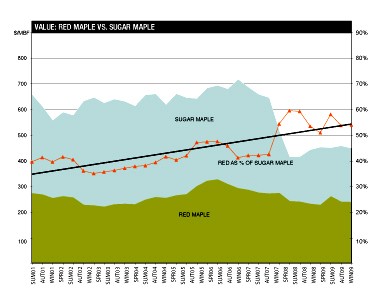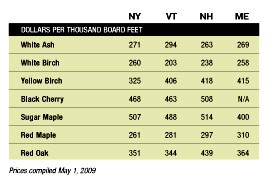Editor’s Note: these are challenging times in the timber industry. Most mills have cut back on production; some are simply not buying logs. Many loggers have had to reduce crew size or find other lines of work. Many buyers are carrying minimum inventories to try to ride out the hard times. The prices reported here reflect changing market conditions, price adjustments to attract deliveries at some mills but not others, and a low volume of transactions. Accurately estimating mill prices during these times is a challenge, to say the least. It is always a good idea for an interested party to call a mill directly for up-to-date specs and prices.
These prices are for #1 hardwood logs, at least 8 feet long, with three clear faces and a minimum 12-inch top diameter. In the timber world, this is a log of average quality, not a prime sawlog and not a poor one.
Landowners should remember that the dollar amount here indicates what is being paid for logs that have been felled, limbed, skidded, bucked, and delivered to a mill or buyer. The costs of logging and trucking need to be subtracted from these figures to arrive at the price paid to the landowner. Because every job is different, these costs vary widely.

Negotiating a fair price requires an understanding of markets and job conditions. It’s recommended that landowners without this knowledge use a forester as an agent. A forester’s fee will add to the cost, but their representation will often result in a higher payment for the timber.
These data are compiled from interviews with suppliers and buyers, and from the most recent print and on-line versions of the Sawlog Bulletin, and are used by permission. Please note that many of these prices were reported three months prior to our publication date, and current prices could be higher or lower.
A common truism in the forest-products world is that red maple is increasingly being substituted for sugar maple in applications that require a reasonably durable, light-colored hardwood. An analysis of Northern Woodlands log prices over the past eight years bears this out: red maple logs, which sold for roughly a third the price of sugar maple logs in 2001, have now risen to more than half the price.


